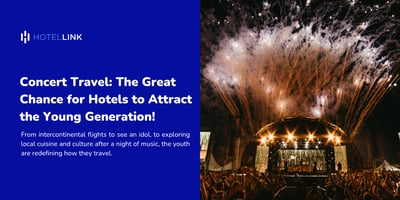In recent years, an increasing number of young people choose "concert ticket hunting" as a reason...
5 Essential Hotel KPIs to Track for Success
The hotel industry is always highly competitive, requiring regular monitoring and evaluation of performance. Using key performance indicators (KPIs) is key to helping you identify strengths and weaknesses, make informed decisions, and optimize business operations. Here are 5 important KPIs every hotel should track:
1. Occupancy Rate (OR)
Occupancy Rate: Occupancy Rate is a measure of the ratio of rooms sold to the total number of rooms available during a given period. This is the most basic and important KPI, helping to evaluate room utilization efficiency and potential revenue. A high Occupancy Rate shows that the hotel is operating effectively, attracting many customers. The ideal Occupancy Rate level depends on many factors such as hotel type, location, travel season, etc. However, the average Occupancy Rate for 4-star hotels is usually 70-80%, 3-star is 60-70%, and 2-star is 50-60%.
Occupancy Rate (OR) is a crucial hotel KPI, but it's not a one-size-fits-all metric. Here's a breakdown to help you analyze OR effectively:
- Seasonality: Travel patterns fluctuate throughout the year. A high OR during peak season is expected, while a lower OR during off-seasons might still be considered successful. Analyze OR trends over time to identify seasonal variations and adjust pricing strategies accordingly.
- Hotel Type & Location: Luxury hotels in tourist destinations might have different OR expectations compared to budget motels near highways. Benchmark your OR against competitors within your category and location for a more accurate picture.
- Length of Stay: A high OR with shorter stays might indicate higher turnover and potentially busier operations. Conversely, a lower OR with longer stays could suggest attracting guests seeking extended getaways. Analyze this alongside OR to understand guest behavior.
- Distribution Channels: The mix of booking channels (direct bookings vs. OTAs) can impact OR. Analyze OR for each channel to identify the most effective ones in driving room sales.
- Revenue per Available Room (RevPAR): While OR focuses on room occupancy, RevPAR considers both occupancy and room rates. A high OR might not translate to high RevPAR if room rates are low. Analyze both metrics together for a more comprehensive picture of revenue generation.
2. Average daily rate (ADR)
ADR, or Average Daily Rate, is a key performance indicator (KPI) that reflects the average revenue generated per occupied room in a specific period (usually daily). However, a high ADR doesn't necessarily equate to optimal hotel performance. Here's a deeper look at ADR:
- Impact on Revenue Generation: A rising ADR indicates the hotel's ability to command higher room rates, potentially leading to increased revenue. This can be achieved through factors like attracting a higher-paying guest segment, offering premium room upgrades, or implementing dynamic pricing strategies.
- Balance with Occupancy Rate: While a high ADR is desirable, it shouldn't come at the expense of occupancy. An excessively high ADR might deter budget-conscious travelers, leading to lower occupancy and ultimately impacting overall revenue. It's crucial to find the sweet spot between ADR and Occupancy Rate (OR) to maximize total revenue (RevPAR - Revenue per Available Room).
- Factors Affecting ADR: Several factors influence ADR, including:
- Hotel Brand & Reputation: Luxury hotels with established brand recognition can typically command higher ADRs.
- Location & Amenities: Hotels in prime locations or offering unique amenities might justify higher room rates.
- Seasonality & Demand: During peak seasons or high-demand events, hotels can potentially raise ADRs.
- Distribution Channels: The mix of booking channels (direct bookings vs. OTAs) can impact ADR. Direct bookings might yield high

3. Revenue per Available Room (RevPAR)
RevPAR, or Revenue per Available Room, is a critical KPI that combines two key metrics: Occupancy Rate (OR) and Average Daily Rate (ADR). It essentially reflects the total revenue a hotel generates from each available room during a specific period (usually daily). Here's why RevPAR is so crucial:
- Comprehensive Performance Indicator: Unlike OR or ADR alone, RevPAR provides a more holistic view of a hotel's revenue generation effectiveness. It considers both the ability to fill rooms (occupancy) and the price at which they are sold (ADR).
- Optimizing Revenue Generation: A rising RevPAR indicates the hotel's success in maximizing revenue from its available rooms. This can be achieved through strategies that improve OR, ADR, or both.
- Benchmarking Hotel Performance: RevPAR allows for a more accurate comparison of hotel performance across different properties. Since it considers both occupancy and pricing strategies, it provides a fairer comparison than solely relying on OR or ADR.
4. Conversion Rate (CR)
Conversion Rate (CR) is a vital KPI for hotels, measuring the effectiveness of your website and marketing efforts in converting website visitors into paying guests. It's calculated by dividing the number of bookings generated by the total number of website visitors or contacts with the hotel (e.g., email inquiries). Here's a deeper look at CR:
- Marketing & Sales Efficiency: A high Conversion Rate indicates that your marketing and sales strategies are successfully attracting potential customers and convincing them to book a stay at your hotel. This could be due to factors like a user-friendly website, compelling content, targeted advertising campaigns, or effective call-to-action prompts.
- Optimizing Website & Booking Process: CR can help identify areas for improvement on your hotel website and booking process. Analyze user behavior and conversion funnel data to see where potential customers drop off. This could be due to a confusing website layout, a complex booking process, or lack of trust signals.
- Benchmarking Online Presence: While average CR benchmarks exist for the hotel industry, it's valuable to compare your performance with similar hotels in your region or category. This provides a more relevant context for understanding your online conversion effectiveness.

5. Customer Satisfaction Index (CSI)
Customer Satisfaction Index (CSI) is a crucial KPI that measures guest satisfaction with the overall hotel experience, encompassing factors like service quality, amenities, cleanliness, value for money, and overall impression. A high CSI indicates that your hotel delivers exceptional service, meets guest expectations, and fosters positive brand perception. Here's why CSI is so important:
- Guest Loyalty & Retention: Satisfied guests are more likely to return for future stays, recommend your hotel to others, and generate positive online reviews. A high CSI can lead to greater customer loyalty and retention, ultimately impacting your bottom line.
- Service Quality Benchmarking: CSI helps you benchmark your service quality against industry standards or competitors. Analyzing guest feedback can reveal areas for improvement and identify service gaps that might be impacting guest satisfaction.
- Building Brand Reputation: A strong CSI contributes to a positive brand reputation. Satisfied guests act as brand ambassadors, spreading positive word-of-mouth and attracting new customers through their recommendations and online reviews.
Conclusion
Tracking and evaluating KPIs is essential to ensure operational efficiency and long-term hotel success. Using effective data management and analysis tools will help you accurately track KPIs and make informed decisions based on real data.
Track and improve important KPIs to improve operational efficiency, maximize revenue and increase your hotel's competitive advantage with Hotel Link's accommodation tools and solutions right away! Contact us now!



